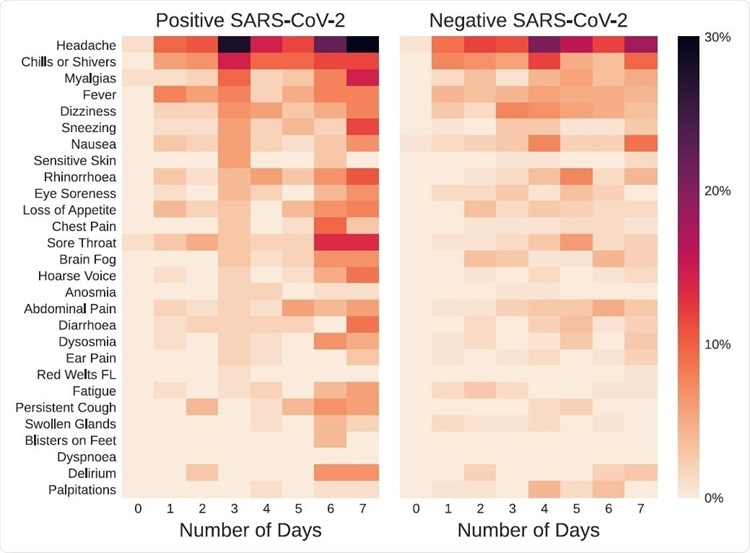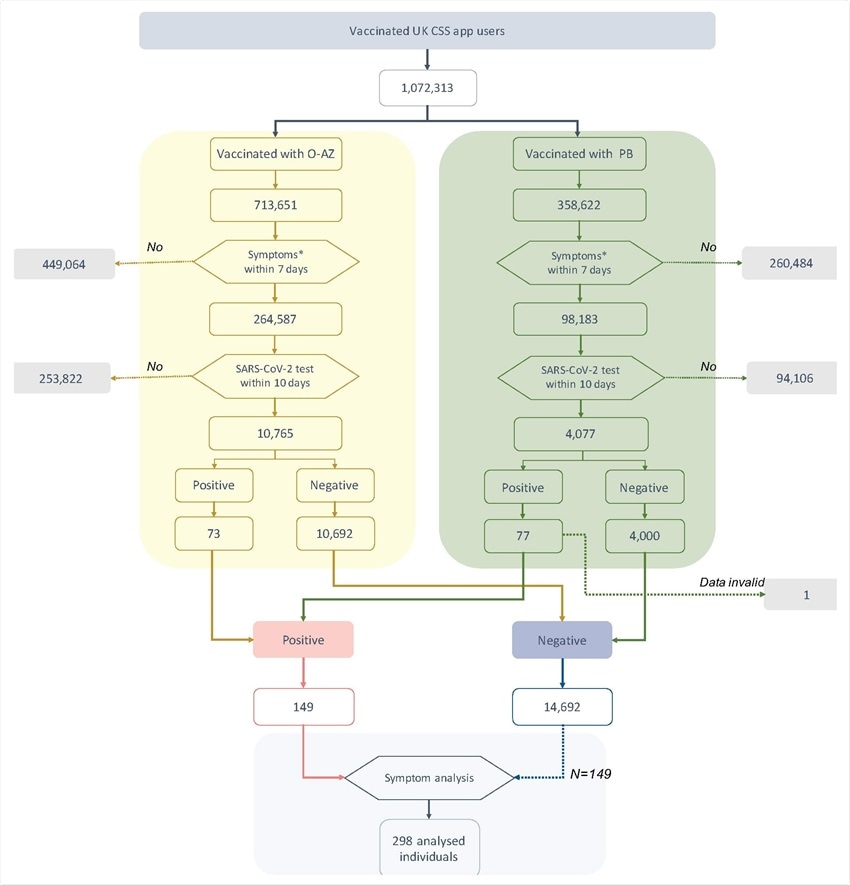Researchers Find It Difficult To Differentiate Between Symptoms Associated With SARS-CoV-2 Vaccination And Early COVID-19 Symptoms
Source: COVID-19 Symptoms Aug 01, 2021 3 years, 8 months, 1 day, 7 hours, 31 minutes ago
Researchers from King’s College London along with experts from University College London have in a new study tried to differentiate the symptoms associated with COVID-19 vaccinations and those that are seen from early COVID-19 infections.
 Symptom prevalence and distribution during the first week after the first dose of vaccination, in symptomatic individuals testing positive or negative for SARS-CoV-2. The color bar represents the percentage of symptomatic individuals reporting each symptom.
Symptom prevalence and distribution during the first week after the first dose of vaccination, in symptomatic individuals testing positive or negative for SARS-CoV-2. The color bar represents the percentage of symptomatic individuals reporting each symptom.
The identification and testing of individuals likely to have SARS-CoV-2 is critical for effective infection control, including post-vaccination.
Vaccination is a major public health strategy to reduce SARS-CoV-2 infection globally. However some individuals experience systemic symptoms post-vaccination, which overlap with COVID-19 symptoms.
The study team compared early post-vaccination symptoms in individuals who subsequently tested positive or negative for SARS-CoV-2, using data from the
COVID Symptoms Study (CSS) app.
The team conducted a prospective observational study in UK CSS participants who were asymptomatic when vaccinated with Pfizer-BioNTech mRNA vaccine (BNT162b2) or Oxford-AstraZeneca adenovirus-vectored vaccine (ChAdOx1 nCoV-19) between 8 December 2020 and 17 May 2021, who subsequently reported symptoms within seven days (other than local symptoms at injection site) and were tested for SARS-CoV-2, aiming to differentiate vaccination side-effects
per se from superimposed SARS-CoV-2 infection.
The post-vaccination symptoms and SARS-CoV-2 test results were contemporaneously logged by participants. Demographic and clinical information (including comorbidities) were also recorded. Symptom profiles in individuals testing positive were compared with a 1:1 matched population testing negative, including using machine learning and multiple models including UK testing criteria.
The study team found
differentiating post-vaccination side-effects alone from early COVID-19 was challenging, with a sensitivity in identification of individuals testing positive of 0.6 at best.
A majority of these individuals did not have fever, persistent cough, or anosmia/dysosmia, requisite symptoms for accessing UK testing; and many only had systemic symptoms commonly seen post-vaccination in individuals negative for SARS-CoV-2 (headache, myalgia, and fatigue).
The study found that
post-vaccination side-effects per se cannot be differentiated from COVID-19 with clinical robustness, either using symptom profiles or machine-derived models. Individuals presenting with systemic symptoms post-vaccination should be tested for SARS-CoV-2, to prevent community spread.
The study findings were published on a preprint server and are currently being peer reviewed.
https://www.medrxiv.org/content/10.1101/2021.07.21.21260906v1
The study findings present an analysis of the differences between recorded vaccination side effects vs. earl
y COVID-19 symptoms.
The study team focused on four vaccines, namely, Pfizer-BioNTech (PB) mRNA (BNT162b2) vaccine, based on messenger ribonucleic acid encoding the viral spike protein; the Moderna mRNA (mRNA-1273) vaccine; the Oxford-AstraZeneca (O-AZ) adenovirus-vectored vaccine; and the Janssen adenovirus-vectored Ad26.COV2.S).
These COVID-19 vaccines were rolled out in late 2020/early 2021. Local reactions to the vaccines include tenderness with the O-AZ and pain with the PB vaccine in 76% and 83% of younger recipients, respectively. Other common side effects were fatigue, headache, and fever. More serious was the vaccine-induced immune thrombotic thrombocytopenia (VITT) seen in rare cases following either the O-AZ or Janssen vaccines.
To date, the United Kingdom has seen 70 deaths among 395 cases of VITT, out of over 69 million vaccinations, with over 45 million of these being O-AZ. While severe COVID-19 is more common with age, side effects of the vaccine are more common in younger individuals.
Importantly there is a need to differentiate symptoms of early infection from those due to vaccination since the former mandates patient quarantine to limit transmission. This may be done by testing every individual with COVID-19-like illness (CLI), but it is cumbersome due to the cost and effort involved.
The study team aimed to differentiate those who have systemic side-effects of vaccination from those who also have breakthrough infections.
The team found that over one million UK CSS app users who had taken either the O-AZ or PB vaccine, one in three, had one or more symptoms soon thereafter. The SARS-CoV-2 test was carried out in 4% of them, with 1% (n=150) eventually being confirmed to have an infection. This accounted for ~0.7% and 1.9% of the tested groups who had received the O-AZ and PB vaccines, respectively.
It was found that of the tested individuals, numbering ~15,000, a quarter had CLI, of whom less than 2% were positive.
In contrast, of the >11,000 who had no symptoms of CLI, 0.8% tested positive, indicating that these symptoms indicate a higher risk of test positivity. In absolute terms, however, the opposite is true since 88 of 150 test positives were missed by the use of symptoms alone.
 lowchart of individuals included in this study. Symptoms within 7 days excluded local symptoms related to injection site. SARS-CoV-2 test included both rtPCR and LFAT. Positive and negative refers to self-logged test results.
Interestingly some symptoms such as headache and muscle pain increased in prevalence over time irrespective of test positivity. Sneezing and hoarseness increased only in those who tested positive, however. Fever and sore throat were, conversely, increased in the test negatives.
Also the most prolonged duration of symptoms in the latter category was for alterations in smell and for delirium. However, no formal difference was observed for the duration in positive vs. negative individuals.
lowchart of individuals included in this study. Symptoms within 7 days excluded local symptoms related to injection site. SARS-CoV-2 test included both rtPCR and LFAT. Positive and negative refers to self-logged test results.
Interestingly some symptoms such as headache and muscle pain increased in prevalence over time irrespective of test positivity. Sneezing and hoarseness increased only in those who tested positive, however. Fever and sore throat were, conversely, increased in the test negatives.
Also the most prolonged duration of symptoms in the latter category was for alterations in smell and for delirium. However, no formal difference was observed for the duration in positive vs. negative individuals.
The team aimed to develop a workflow that would sort symptoms to predict the risk of infection in symptomatic cases in the early post-vaccination period. This could help direct testing towards the high-risk segment, saving limited resources in low- and middle-income countries.
The researchers admitted that they could not find a reliable distinction between symptoms due to the vaccination and those due to superimposed SARS-CoV-2 infection.
The detailed analysis also showed minimal testing among symptomatic vaccine recipients. Even when their symptoms fulfilled the criteria for CLI, only 40% were tested.
However the reason for the low rate of testing in the face of readily available facilities in the UK is unclear.
Also of the 150 people who had a positive test result, only 40% had CLI, and the rest were tested for reasons other than the presence of such symptoms.
It was found that the use of core symptoms as an indicator of testing may miss out on many test positives, suggesting the need to refine the policy in the UK, and widen the testing net.
Importantly the fact that symptoms could not clearly demarcate test positives from negatives early in the illness means that this cannot be developed into an algorithm to identify those who should be tested and isolated.
It should be noted that the time of infection in these cases is unknown, though the study criteria ensured that only recent infections were included. However, the infection may have occurred before vaccination since many infections are asymptomatic and in this case, the study required that all vaccine recipients included be asymptomatic.
Also the infection may also have occurred during vaccination. However, the severity of the illness is much lower after vaccination than in unvaccinated individuals.
Furthermore vaccination may have induced a sense of false security, which led to riskier behavior and a greater likelihood of infection. This corroborates the findings of some earlier studies.
The study team concluded, “Post-vaccination symptoms cannot be distinguished with clinical confidence from early SARS-CoV-2 infection. Our study highlights the critical importance of testing symptomatic individuals even if recently vaccinated to ensure early detection of SARS-CoV-2 infection and help prevent future waves of COVID-19.”
For the latest on
COVID-19 Symptoms, keep on logging to Thailand Medical News.

